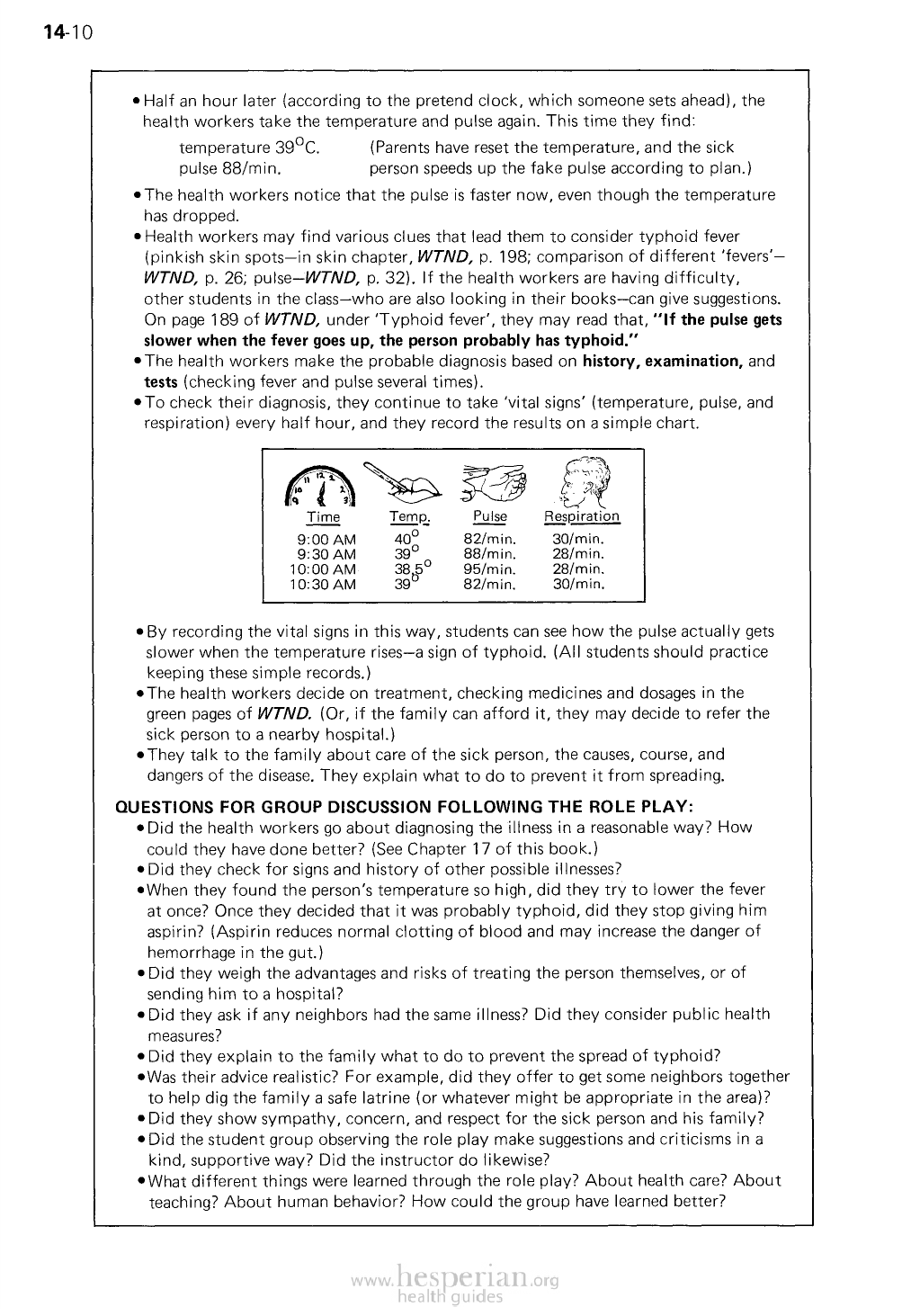
14-10
• Half an hour later (according to the pretend clock, which someone sets ahead), the
health workers take the temperature and pulse again. This time they find:
temperature 3939°C. (Parents have reset the temperature, and the sick
pulse 88/min.
person speeds up the fake pulse according to plan.)
• The health workers notice that the pulse is faster now, even though the temperature
has dropped.
• Health workers may find various clues that lead them to consider typhoid fever
• (pinkish skin spots—in skin chapter, WTND, p. 198; comparison of different ‘fevers’—
WTND, p. 26; pulse-WTND, p. 32). If the health workers are having difficulty, other
students in the class—who are also looking in their books—can give suggestions. On
page 189 of WTND, under Typhoid fever#’, they may read that, “If the pulse gets
slower when the fever goes up, the person probably has typhoid.”
• The health workers make the probable diagnosis based on history, examination,
and tests (checking fever and pulse several times).
• To check their diagnosis, they continue to take ‘vital signs’ (temperature, pulse, and
• respiration) every half hour, and they record the results on a simple chart.
Time
9:00 AM
9:30 AM
10:00 AM
10:30 AM
Temp.
40°
39°
385°
39°
Pulse
82/min.
88/min.
95/min.
82/min.
Respiration
30/min.
28/min.
28/min.
30/min.
• By recording the vital signs in this way, students can see how the pulse actually gets
slower when the temperature rises—a sign of typhoid. (All students should practice
keeping these simple records.)
• The health workers decide on treatment, checking medicines and dosages in the
green pages of WTND. (Or, if the family can afford it, they may decide to refer the sick
person to a nearby hospital.)
• They talk to the family about care of the sick person, the causes, course, and dangers
of the disease. They explain what to do to prevent it from spreading.
QUESTIONS FOR GROUP DISCUSSION FOLLOWING THE ROLE PLAY:
• Did the health workers go about diagnosing the illness in a reasonable way? How
could they have done better? (See Chapter 17 of this book.)
• Did they check for signs and history of other possible illnesses?
• When they found the person’s temperature so high, did they try to lower the fever
at once? Once they decided that it was probably typhoid, did they stop giving him
aspirin? (Aspirin reduces normal clotting of biood and may increase the danger of
hemorrhage in the gut.)
• Did they weigh the advantages and risks of treating the person themselves, or of
sending him to a hospital?
• Did they ask if any neighbors had the same illness? Did they consider public health
measures?
• Did they explain to the family what to do to prevent the spread of typhoid?
• Was their advice realistic? For example, did they offer to get some neighbors together
to help dig the family a safe latrine (or whatever might be appropriate in the area)?
• Did they show sympathy, concern, and respect for the sick person and his family?
• Did the student group observing the role play make suggestions and criticisms in a
kind, supportive way? Did the instructor do likewise?
• What different things were learned through the role play? About health care? About
teaching? About human behavior? How could the group have learned better?